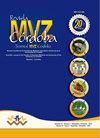墨西哥分离的鲤鱼春季病毒血症病毒的复制和存活特征
IF 0.3
4区 农林科学
Q4 AGRICULTURE, DAIRY & ANIMAL SCIENCE
引用次数: 0
摘要
目标。目的:对鲤鱼春季病毒血症(SVCV)进行分离,并评价其在不同细胞类型下的生长情况和不同温度下的病毒存活率。材料和方法。在墨西哥中部的一个泻湖中处理了10条400-500克的鲤鱼,通过细胞培养分离和RT-PCR诊断SVCV。将获得的病毒分别接种于EPC、BF-2、CHSE-214和RTG-2细胞,观察病毒生长的差异;还评估了病毒在室温(20-25°C)、冷藏(REF 4°C)和冷冻(long -80°C)下保存11个月的存活率。内部器官标本进行组织学分析。结果。分析的鱼没有显示提示疾病的外部迹象,但观察到内部和组织病理学病变提示全身性感染。在EPC和BF-2细胞中分离到SVCV,并采用半巢式RT-PCR进行证实。SVCV仅在EPC和BF-2细胞中诱导CPE,在RTG-2和CHSE-214中呈阴性。保存在TA处的病毒在感染后4个月(mpi)后失去活力,总数达到6个mpi;而REF和CONG在11个月内保持稳定。结论。在出现与这种感染相关的组织学病变的鲤鱼中证实了亚临床SVCV感染;SVCV仅在EPC和BF-2细胞中引起CPE;在-80°C的冷藏条件下,病毒的生存能力可保持11个月;而TA在6个月后就消失了。本文章由计算机程序翻译,如有差异,请以英文原文为准。
Características de replicación y supervivencia del virus de viremia primaveral de la carpa (SVCV) aislado en México
Objective. To perform the isolation of spring viraemia of carp virus (SVCV) in common carp (Cyprinus carpio) and evaluate its growth in different cell types and viral survival at different temperatures. Materials and methods. Ten carps of between 400-500 grams of a lagoon in central Mexico were processed for diagnosis of SVCV by isolation in cell culture and by RT-PCR. The virus obtained was inoculated into EPC, BF-2, CHSE-214 and RTG-2 cells to determine differences in virus growth; the survival of virus stored at room temperature (TA 20-25 °C), refrigeration (REF 4° C) and freezing (CONG -80 °C) up to eleven months was also evaluated. Internal organ samples were processed for histological analysis. Results. The fish analyzed did not show external signs suggestive of disease but internally and histopathologically lesions suggestive of systemic infection were observed. SVCV was isolated in EPC and BF-2 cells, and confirmed by semi-nested RT-PCR. SVCV only induced CPE in EPC and BF-2 cells, and was negative in RTG-2 and CHSE-214. The virus conserved at TA lost viability after four months post-infection (mpi), being total at six mpi; while REF and CONG were stable during the eleven months. Conclusions. Subclinical SVCV infection was confirmed in carp that presented histological lesions associated with this infection; SVCV only caused CPE in EPC and BF-2 cells; and the virus kept in refrigeration and at -80 °C retained its viability up to eleven months; while TA was lost in six months.
求助全文
通过发布文献求助,成功后即可免费获取论文全文。
去求助
来源期刊

Revista Mvz Cordoba
农林科学-奶制品与动物科学
CiteScore
0.70
自引率
0.00%
发文量
41
审稿时长
6-12 weeks
期刊介绍:
The Journal MVZ Córdoba is an open access international scientific journal financed and edited by the University of Córdoba (Colombia). The journal publishes quarterly, continuously in PDF, XML, Epub, original articles, literature reviews, brief communications and clinical cases, peer-reviewed (double-blind) in Spanish and English, which are related to the agricultural and veterinary sciences. The journal is directed to natural and legal persons of veterinary medicine, animal husbandry, public health, epidemiology, aquaculture, biology, basic biomedical sciences and biotechnology and constitutes a space for academic and scientific discussion around the work of professionals in Veterinary Medicine and Zootechnics. Four-monthly publication.
"The Journal MVZ Córdoba supports the policies for registration of clinical trials of the World Health Organization (WHO) and the International Committee of Medical Journal Editors (ICMJE), since it recognizes the importance of these initiatives for international registration and dissemination. of information about clinical studies, in open access. As a result, since 2007, the journal MVZ Córdoba only publishes clinical research articles that have received an identification number in one of the Clinical Trial Registries validated by the criteria established by WHO and ICMJE, whose addresses are available in the ICMJE website. The identification number is recorded at the end of the summary. "
 求助内容:
求助内容: 应助结果提醒方式:
应助结果提醒方式:


